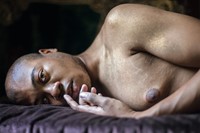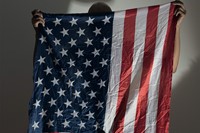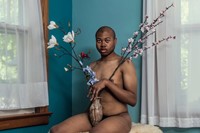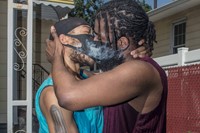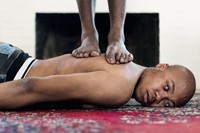D’Angelo Lovell Williams’ surreal debut photo book explores Black queer bodies as a site of gender, racial, and familial expression
D’Angelo Lovell Williams’ photographs are emphatic, intimate, and visceral. The bodies depicted in them – of Williams and their lovers, family members, and friends – are elastic. They bend, stretch, and pull. Hands reach, touch, and hold, and each gesture is potent with meaning.
Last month, Mack published Williams’s first photo book, Contact High, a collection of 45 photographs chronicling the Mississippi-born photographer’s work. Contact High originated from a portfolio of 32 images made in collaboration with Higher Pictures Generation, the Brooklyn-based gallery that represents Williams, and the photographs in the book were taken in Virginia, Mississippi, New York, Maine and Wisconsin – mostly while Williams was a graduate student at Syracuse. There, they first encountered the work of Lyle Ashton Harris and the late Rotimi Fani-Kayode, photographers whose works explored Black male bodies and exalted queer desire.
“[The work] really started with my relationship to my own body, visualising my own body because I hadn’t really seen it be uplifted,” says Williams. When it was time to put together a book, it was important to Williams that the project reflected their everyday experience; embedded in Contact High, therefore, is an exploration of the mundane. “I consider my work surreal, but I think of the surreal beyond the definition of what we know it as,” Williams explains. “The surreal is very mundane.”
There is also a sense of the uncanny in Williams’ photographs; the familiar flipped on its head. In Until We Separate (Mom), Williams lays on their mother’s lap, her hand cradling their head. Both look directly at the camera, their gaze firm, the shape and shade of their eyes startlingly identical. A thin string of red gum stretches between their lips. The two pose as mother and child but could easily be siblings, even twins.

The book’s title, too, is layered in meaning. “The images elevate the idea of contact,” says Williams. There is the obvious definition, feeling euphoric from a bodily encounter, but also “being able to contact ancestors through gut feeling, through trusting your intuition. Contact through spirituality, through the self and through others,” Williams elaborates. Here, bodily contact becomes a route to knowledge.
There is a sculptural quality to many of the images, as well as literal gestures towards Magritte and Matisse. Williams explores the body as a site of gender, racial, and familial expression, as well as the roles our bodies take on or inhabit across all contexts – romantic, sexual, filial, and social. In doing so, they engage with a complex set of discourses surrounding the politics of image-making while offering a visual language that is all their own, centered around Black, queer bodies. “Being visible is important. The Black body hasn’t been visible in certain ways. It’s been written about and visualised in many ways, but not necessarily by Black and queer people ourselves,” says Williams. “A lot [comes up] through the visualisation of the Black figure. How do you not undo, but be in conversation with, those ideas?”

In the essay The Dystopic Cinematic, which accompanies the work, artist Tiona Nekkia McClodden offers “the Black figure” as a more dynamic alternative to “the Black body”. Williams agrees. “It makes more sense,” Williams explains. “The images are very gestural, dancer-like.” A gesture can tell a story, a touch can be a corrective, and for every action, there is its bodily reverse. In I’ll be up there in a minute, the familiar pose of a lynched body takes on new meaning and becomes a reversal, a body in ascension, in flight.
The photographs in the collection are broken up by three poems, Fairy Reversal, Hang Time, and Backwoods; in them, Williams elaborates on many of the themes latent in the work: ancestry, kinship, power, and death. The language is dense with lush imagery. There is a sense of liminality, like we’re in the midst of a teetering moment, the world held on its edge. Contact High captures the precarity and thrill of having a body. For what else do we have? “I sit inside a vessel,” the first line to Fairy Reversal reads, while Williams concludes: “it’s not about making a Utopia, or leaving the world we exist and live in, but finding places where we can exist as ourselves.”
Contact High by D’Angelo Lovell Williams is published by Mack and is out now.

